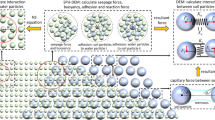Abstract
Seepage in the foundation and abutments of a dam can lead to wasting of the stored water in the reservoir, erosion of the foundation materials and increasing the uplift pressure. It can endanger the long term stability of the dam. Cement grouting is one of the seepage control methods which is generally implemented according to the Lugeon test results. In this study, the grout volume has been examined against Q-value, Lugeon number, SPI (Secondary permeability index) value and joint apertures in the Bakhtiari dam site. In Bakhtiari dam site, the left and the right abutment trial grouting boreholes were drilled up to the final depth of 60 and 100 m, respectively. Limestone of the Sarvak Formation is the dominant rock type in the site. The Q-system parameters have been evaluated by eye-examination of rock cores, the Lugeon numbers and SPI values have been deduced from the water pressure tests and the joint apertures have been calculated based on the permeability of rock mass and the joints spacing. The Q-value, the Lugeon number, the SPI value and the joint aperture have been compared with measured cement take and grout take in the trial grouting boreholes. A general correlation exists, especially when the mentioned parameters have been compared with normalized grout take. Against these general agreements the coefficients of determination for the fitted relations are low or moderate, and it seems that more research has been needed to assessing a reliable predictive relation for the grout and cement takes.













Similar content being viewed by others
References
Barton N (2002) Some new Q-value correlations to assist in site characterization and tunnel design. Int. J Rock Mech Min Sci 39:185–216
Barton N, Quadros EF (1997) Joint aperture and roughness in the prediction of flow and groutability of rock masses. Int J Rock Mech Min Sci 34:3–4, Paper No. 252
Barton N, Lien R, Lunde J (1974) Engineering classification of rock masses for the design of tunnel support. Rock Mech 6:189–236
Clarck C, Budavari S (1981) Correation of rock mass classification parameters obtained from borecore and in-situ observation. Eng Geol 17:19–53
Deere DU (1989) Rock quality designation (RQD) after 20 years. US. Army Corps Engrs. Contract Report GL-89-1. Waterways Experimental Station, Vicksburg
El-Naqa A (2001) The hydraulic conductivity of the fractures intersecting Cambrian sandstone rock masses, central Jordan. Environ Geol 40:973–982
Ewert FK (1985) Rock grouting with emphasis on dam sites. Springer, Berlin
Ewert FK (1997) Permeability, groutability and grouting of rocks related to dam sites; part 4. groutability and grouting of rock. Dam Eng 8(4):271–325
Fell R, Mac Gregor P, Stapledon D, Bell G (2005) Geotechnical engineering of dams. Taylor & Francis, London
Foyo A, Sánchez MA, Tomillo C (2005) A proposal for a secondary permeability index obtained from water pressure tests in dam foundations. Eng Geol 77(1):69–82
Fransson A (2001) Characterization of a fractured rock mass for a grouting field test. Tunnel Undergr Sp Technol. 18:321–330
Funehag J, Fransson A (2006) Sealing narrow fractures with a Newtonian fluid: model prediction for grouting verified by field study. Tunn Undergr Sp Technol 21(5):492–498
Gustafson G, Stille H (1996) Prediction of groutability from grout properties and hydrogeological data. Tunn Undergr Sp Technol 11(3):325–332
Hässler L, Håkansson U, Stille H (1992) Classification of jointed rock with emphasis on grouting. Tunn Undergr Sp Technol 7(4):447–452
Houlsby AC (1990) Construction and design of cement grouting: a guide to grouting in rock foundations (Vol. 67). John Wiley & Sons, Hoboken
Iran Water and Power Resources Development Company (IWPRDC) (2009) Engineering geology report phase I feasibility phase Bakhtiari reservoir dam
ISRM (1978) Rock characterization testing and monitoring: suggested methods for quantitative description of fractures in rock masses. Int J Rock Mech Min Sci Geomech Abstr 15:319–368
Louis C (1974) Introduction an l’hydraulique des roches. Bull BRGM 2ième Série Sect III 4:283–356
Nonveiller E (1989) Grouting theory and practice, development of geotechnical engineering. Elsevier, Amsterdam
Priest SD, Hudson JA (1976) Discontinuity spacing in rock. Int J Rock Mech Min Sci 13:135–148
Sadeghiyeh SM, Hashemi M, Ajalloeian R (2013) Comparison of permeability and groutability of ostur dam site rock mass for grout curtain design. Rock Mech Rock Eng 46(2):341–357
Stille H, Gustafson G, Hassler L (2012) Application of new theories and technology for grouting of dams and foundations on rock. Geotech Geol Eng 30:603–624
Zhang L (2013) Aspects of rock permeability. Front Struct Civ Eng 7(2):102–116
Acknowledgments
This research was supported under the School of Geology, University College of the Sciences, University of Tehran, Iran. The authors also would like to thank Iran Water and Power Resources Development Company (IWPRDC) for field test data of the trial grouting boreholes.
Author information
Authors and Affiliations
Corresponding author
Rights and permissions
About this article
Cite this article
Sohrabi-Bidar, A., Rastegar-Nia, A. & Zolfaghari, A. Estimation of the grout take using empirical relationships (case study: Bakhtiari dam site). Bull Eng Geol Environ 75, 425–438 (2016). https://doi.org/10.1007/s10064-015-0754-5
Received:
Accepted:
Published:
Issue Date:
DOI: https://doi.org/10.1007/s10064-015-0754-5




